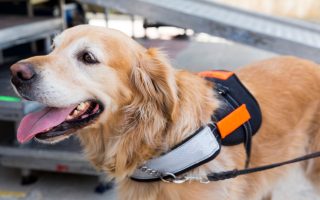Life is all about balance – everything works well if it is balanced, and if you fail to maintain that balance. A lot of bad things can happen. Just like humans, and other living creatures as well, dogs require adequate dietary intake in order to be at their healthiest. Here are 10 Signs You Are overfeeding your labrador.

Whereas we, as pet lovers, are passionate about overfeeding your labrador, and genuinely care about their well-being. Sometimes though, this can lead to overindulgence.
According to research published by Banfield Pet Hospital, 1 in 4 dogs in the United State suffer from overweight or obesity.
There are many reasons why you might give your labrador too many treats. Whether you’re unknowingly stuffing their bowl with too many treats or giving them extra treats because they’re so cute. But this is not recommended by many veterinary experts if you want to keep them in good health.
Whereas labradors are becoming overweight at an alarming rate due to excessive feeding. But, the underlying metabolic processes have not yet been fully elucidated. That’s why today we came up with the 10 signs to look out for that show that you are overfeeding your labrador..
Throughout this article, our sole purpose is to keep you well-informed about possible health complications associated with Labradors. Keep reading!
Overfeeding Your Labrador.: What happens when they are overfed?
Some dog owners have an incorrect belief that they should constantly feed their labradors. As the dog owners tend to believe that the more they consume, the healthier their pet will be. However, it really works the opposite way around.
It’s recommended to feed your labrador based on his/her age and the kind of food you give.
It is not uncommon to find pet owners who can’t even differentiate between a healthy labrador and an overfed labrador which leads them to feed their Labradors too much, the majority of the time.
A healthy labrador is much different from one that has been overfed. A healthy Labrador can weigh 55 to 75 pounds, while an overweight labrador can weigh more than 100 pounds, which is concerning. That’s why it’s important for pet owners to know the difference.
When overfed, a labrador may suffer from serious health issues such as:
- Arthritis
- Diabetes
- Heart diseases
- Reduced lifespan
You must therefore be on the lookout for signs of overfeeding in your labrador. It may differ based on your pet’s unique circumstances, so it’s better to discuss dietary issues with your veterinarian.
Overfeeding Labradors: 10 signs to look out for
New York veterinarian Danny Tufaro shares his advice on how to prevent overfeeding your pets.
We’ve compiled a list of the 10 signs that you should look out for when assessing whether your Labrador is overfed or not.
#1 – Your labrador’s bulging belly is a clear sign
It may be a no-brainer, but the most obvious way to find out. If your labrador is overfeeding is to examine his or her waist. You should observe whether his belly slopes upward beneath his belly, whether it is level between his legs, or if it is convex among his legs.
It is best if the labrador has a slope that extends upwards from the bottom of his chest, in the direction of his rear legs. Then, observe your labrador from the above position. Is there an apparent waist in front of his hips? Does he appear to have one? If so, you must see one.
There shouldn’t be a uniform width all along a labrador’s body.
Examine your dog once more from an angle. Are there any ribs visible?
Labradors’ ribs shouldn’t be visible when they are standing still. However, some may be visible with movement, such as eating, drinking, and twisting.
If necessary, you can also use the internet to look up pictures of healthy labradors, and compare your lab with them.
#2 – Your labrador’s bowel movements aren’t normal
Your labrador’s bowel movements say a lot about whether you overfeed them. It is common for pet owners to claim that their pets cannot be overfed since they don’t weigh too much, though this may not always be true.
Your labrador is overfeeding if he poos soft after mealtimes.
Not only this, overeating can lead to other health problems as well, like constipation, digestive problems, and inflammation. Your puppy may be eating too much if they have normal stools beforehand, followed by soft stools afterward.
#3 – Your labrador has become more sluggish than before
A Labrador puppy’s energy level is at the peak of its early development period. Playfulness and bouncing around are the most important aspects of this period of their lives.
This energy is only fueled by curiosity. There are, after all, a lot of unfamiliar things in the world. Therefore, if your labrador puppy does not seem to be doing well, overeating might be to blame.
Despite the symptom’s vagueness, there are a number of potential health problems that can be triggered, including the possibility of a pet losing energy caused by excess weight that makes it harder for the pet to run, jump, or play, say veterinarians at Greencross.
The sluggishness usually follows a meal, or sometimes even a nap. The sluggishness should, however, not linger for too long. As soon as the pup wakes up, its energy level will return to where it was before.
The first time your pet exhibits a significant change in behavior, make an appointment with your veterinarian. No matter what the cause, this type of change must be monitored to ensure a healthy pet.
#4 – Your labrador now struggles with maintaining a clean coat
In case, your labrador now struggles with maintaining a clean coat but had previously maintained it consistently, overweight is clearly evident.
When your labrador has become overweight from eating too much, unfortunately, cleaning those hard-to-reach areas becomes nearly impossible. Labradors’ way of cleaning themselves involves them licking vigorously.
The aging process, arthritis, and other health conditions, too, contribute to difficulties in cleaning.
#5 – Your labrador now struggles with excessive bloating
It is true that some breeds are prone to gassier than others, however, having a gassy period that doesn’t smell like normal often indicates that they may be experiencing issues within their bodies.
Ingesting excessive amounts of any food, however healthy, can cause gastrointestinal problems, with flatulence being a common side effect.
Dogs have balloon-shaped stomachs, much like humans. People, who eat fast eating or eat too much may experience gas, bloating, and other symptoms, although they recover quickly.
In Labrador, however, the situation is different, as what begins as gas can quickly deteriorate into a much more serious issue. You will be able to see the signs such as:
- Large abdomen
- Physical activity levels fluctuations
- Anxiety
- Whining
- Inability to defecate
#6 – Your labrador now suffers from joint problems
If your labrador is overweight, it is probably due to the fact that he is being overfed by you. This is because Labradors are renowned for their fast-eating style, which may make them seem like they still need food, which is why we provide more. Which indirectly leads to joint problems in labradors.
In addition, if you notice joint discomfort in him, it’s also a red flag, because overweight labs have similar health problems to overweight people.
It is possible for labradors to suffer pain and develop arthritis as a result of joint problems.
Ensure you follow your food of choice recommendation chart as directed. A labrador’s outdoor activity helps keep his weight under control as well.
#7 – Your labrador has started moulting and showing signs of skin disorders
The vast majority of dog owners believe that prolonged moulting is an inevitable part of owning one as it is something they must accept and live with. During moulting, the body expels waste while the body adjusts to the seasons, and moulting occurs on a periodic basis (twice a year), and a host of other skin and coat-related issues, including excessive grooming, chewing on feet, bald patches, and itching are symptoms of a surplus of waste in the body that the labrador is trying to dispose of.
Inflammatory reactions can occur in the body due to sensitivity to certain foods, consuming too many fats or proteins, poor nutrition, or overeating.
Once you figure out the right amount to feed your labrador, you will be amazed at how much lower moulting rates you will experience with your pet.
#8 – When your labrador starts eating feces – either it’s own or someone else’s
Your labrador when fed in an area close to his feces is likely to associate food odors with that of his feces, so he won’t be able to distinguish between the two. On the other hand, there are many myths surrounding dogs eating feces.
Scientifically, coprophagia is the act of eating poop. During my research, I found the paper entitled “Coprophagia – Food for thought” that caught my eye.
Research published in 1988 in the Canadian Veterinary Journal, found that high-carbohydrate diets are more likely to increase the desire of the dog to eat stool more often. Sadly, the authors do not specify the basis for their findings.
Some say, “This is an indication that your dog’s diet is lackluster”, whereas others suggest that it could just be hunger.
#9 – When your labrador starts scratching too often
It is usually the case that a dog will scratch more often than normal, meaning that something is wrong with the internal health of such a dog, which suggests that the dog may be suffering from nutritional problems.
A number of factors are to blame for such a condition – such as poor diet, excessive diet, and sensitivity to certain food ingredients, which your labrador is consuming in huge amounts.
No matter how good the food is, eating an excessive amount can lead to toxic overload in the body, resulting in issues like excessive scratching which leads to bald patches.
#10 – When your labrador exhibits ear problems
Have you tried everything to make your labrador’s ear infections go away, including a vet check for food allergy or over-feeding? These could be at the root of the problem.
Banfield suggests that if you allow your labrador to eat what they please, he or she will consume it without regulating themselves.







